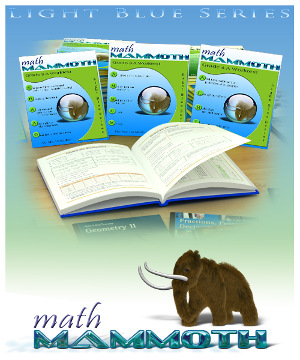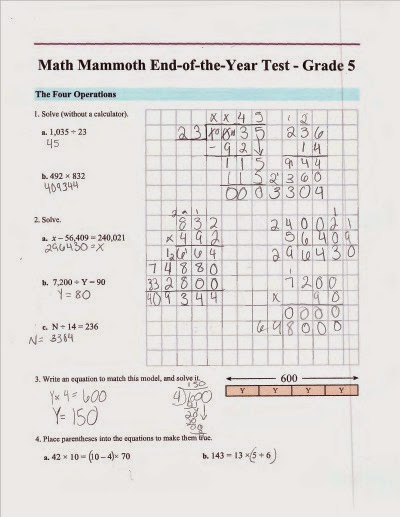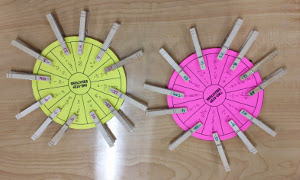 Maria's Math News, October 2014 |
|
Hello!
See how I evaluate a placement test, find out how the mysterious farmer's will was solved, learn about timed tests, and play fraction game and equation wheels! 2. Evaluation of a math assessment test - example (grades 2-7) 3. A farmer and his three sons (grades 3-12) 5. Fraction game: My Closest Neighbor (grades 4-8) 6. Equation wheels (grades 6-9) ~Maria |
Advertisement
|
1. Math Mammoth news A Math Mammoth giveaway is around the corner! Stay tuned - I will send you the details about it in mid-October.
A Math Mammoth giveaway is around the corner! Stay tuned - I will send you the details about it in mid-October.
|
2. Evaluation of a math assessment test - example You might already know that the placement tests on my site work equally well as generic math assessment tests.
You might already know that the placement tests on my site work equally well as generic math assessment tests.I also evaluate the test results for free. Now you can see an example of one student's test results and my evaluation here. Many students need to take two or even more tests in order to get a full picture of the gaps they have in their skills and knowledge. That was the case with this student also: she actually took three tests, grade 6, 5, and 4. I posted two of the tests and my evaluation at MathMammoth.com site. I hope it's helpful! |
4. Timed tests I wrote a new piece outlining some of the dangers of using timed tests in math, such as how they promote math anxiety and cause children to be afraid of making mistakes in math classes.
I wrote a new piece outlining some of the dangers of using timed tests in math, such as how they promote math anxiety and cause children to be afraid of making mistakes in math classes.Should you use timed tests for math facts? Go check it out! |
5. Fraction game: My Closest Neighbor

Fraction 3/10 Deal five cards to each player. In each round, choose two cards from your hand and make a fraction that is as close as possible (but not equal) to the given target number. Then draw two cards from the deck so you have five again. You will play six rounds with these target numbers:
The player whose fraction is closest to the target collects all the cards played in that round. If there is a tie, the players can share the cards evenly or you can device your own rule for how to handle a tie. Fraction Game: My Closest Neighbor |
6. Equation wheels This is another neat idea I saw online. It's for practicing equations but you could adapt it to other things.
This is another neat idea I saw online. It's for practicing equations but you could adapt it to other things.
There is an equation on each spoke of the wheel and the answer to the equation is on a clothes pin. Read more: Equation wheels |
|
That's it for this newsletter! I hope you found something beneficial. Feel free to forward this issue to a friend/colleague! Subscribe here. Till next time, Maria Miller |
| Free worksheets | Games & etc. | Curriculum guide |
| My books | Lessons | Newsletter Archives |
